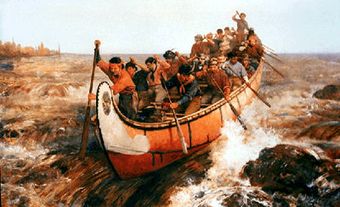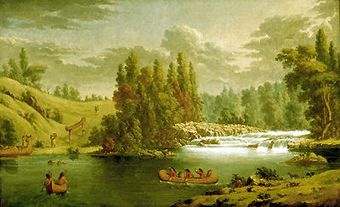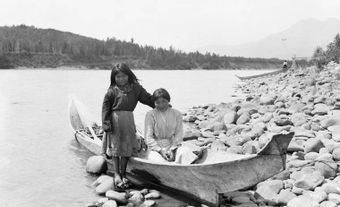The York boat, named for the Hudson’s Bay Company’s York Factory, was one of three types of inland boats (the others being scows and sturgeon-heads) used by the HBC in the fur trade. It was the company’s most suitable boat for lake travel, although it also plied rivers. For about a century beginning the 1820s, this freight-carrying boat was the main mode of transportation between York Factory on Hudson Bay and inland trading posts.
Boatbuilders recruited from the Orkney Islands (see Orkneymen) built the first York boat in the 1740s, and the vessels were soon being used on the Albany River. In competition inland with the North West Company on the Saskatchewan River in the 1790s, the York boat offered the HBC a distinct advantage, since it could carry two to three times the cargo of a canot du nord (see Birchbark Canoe) with the same number of crew. It was also less easily damaged by ice and was safer in storms. On open water, it could be fitted with a mast and a square sail that doubled as a tent when its crew made camp.
The typical York boat had a 9.1 m keel and overall length of 12.6 m, a 2.7 m beam and inside depth of 0.9 m. It carried six to eight tripmen and a cargo of over 2,700 kg. By the late 18th century, the HBC had boat-building stations from James Bay to Fort Chipewyan, and in 1795 York boats were first built at Fort Edmonton. In the early 20th century, York boats were of three sizes based on the amount of cargo they could carry: “60 pieces” (2,700 kg), “100 pieces” (4,535 kg) and “120 pieces” (5,440 kg). By the 1920s, the York boat had largely passed from service. Railways had taken over much of the freight-carrying business.
Since 1973, the Norway House Cree Nation in Manitoba has held the annual Treaty & York Boat Days summer festival. Featuring York boat races, the festival pays tribute to the community’s history as a fur-trading post and honours the tenacity of the community’s Cree, Métis and European founders.

 Share on Facebook
Share on Facebook Share on X
Share on X Share by Email
Share by Email Share on Google Classroom
Share on Google Classroom




